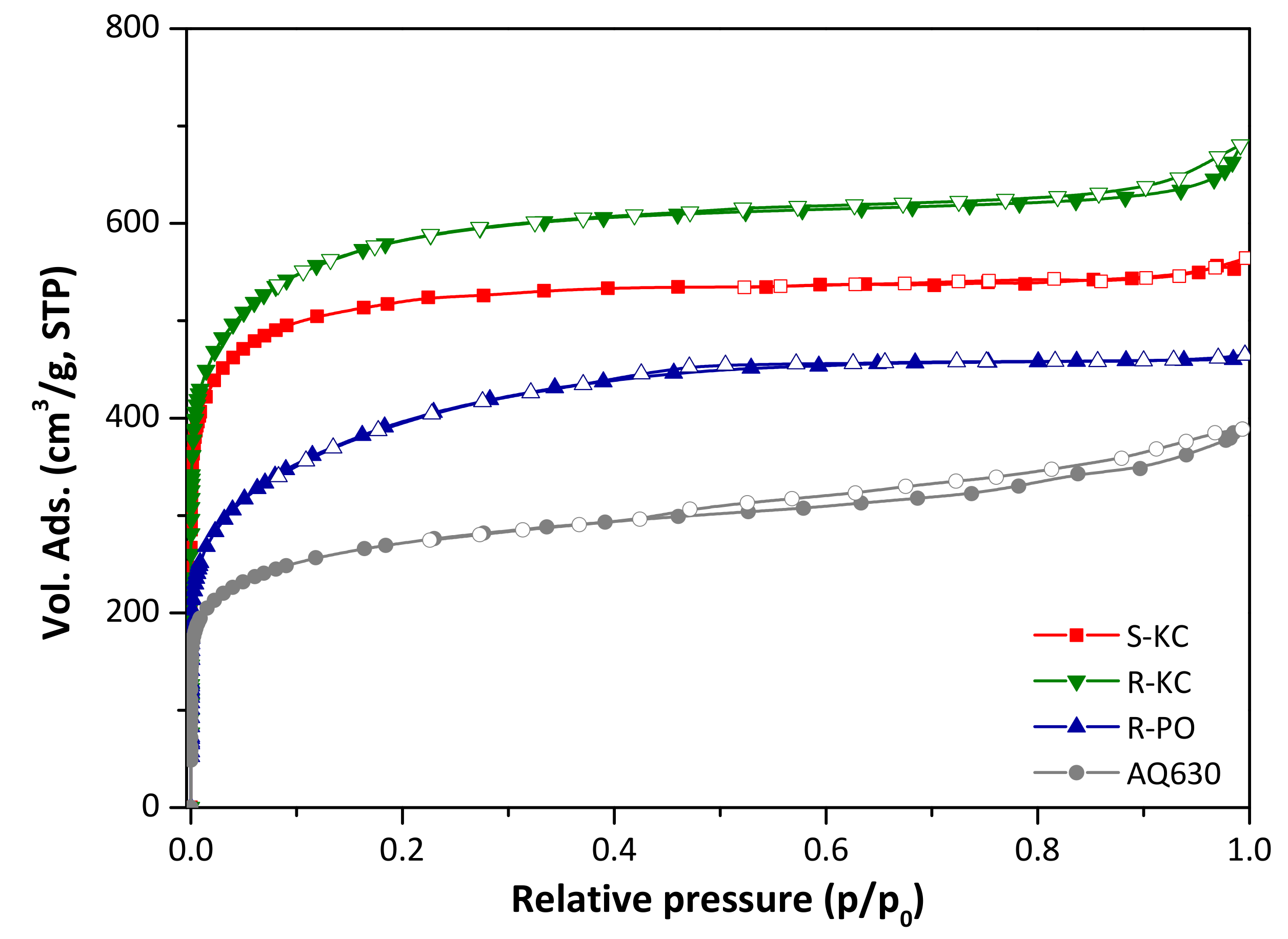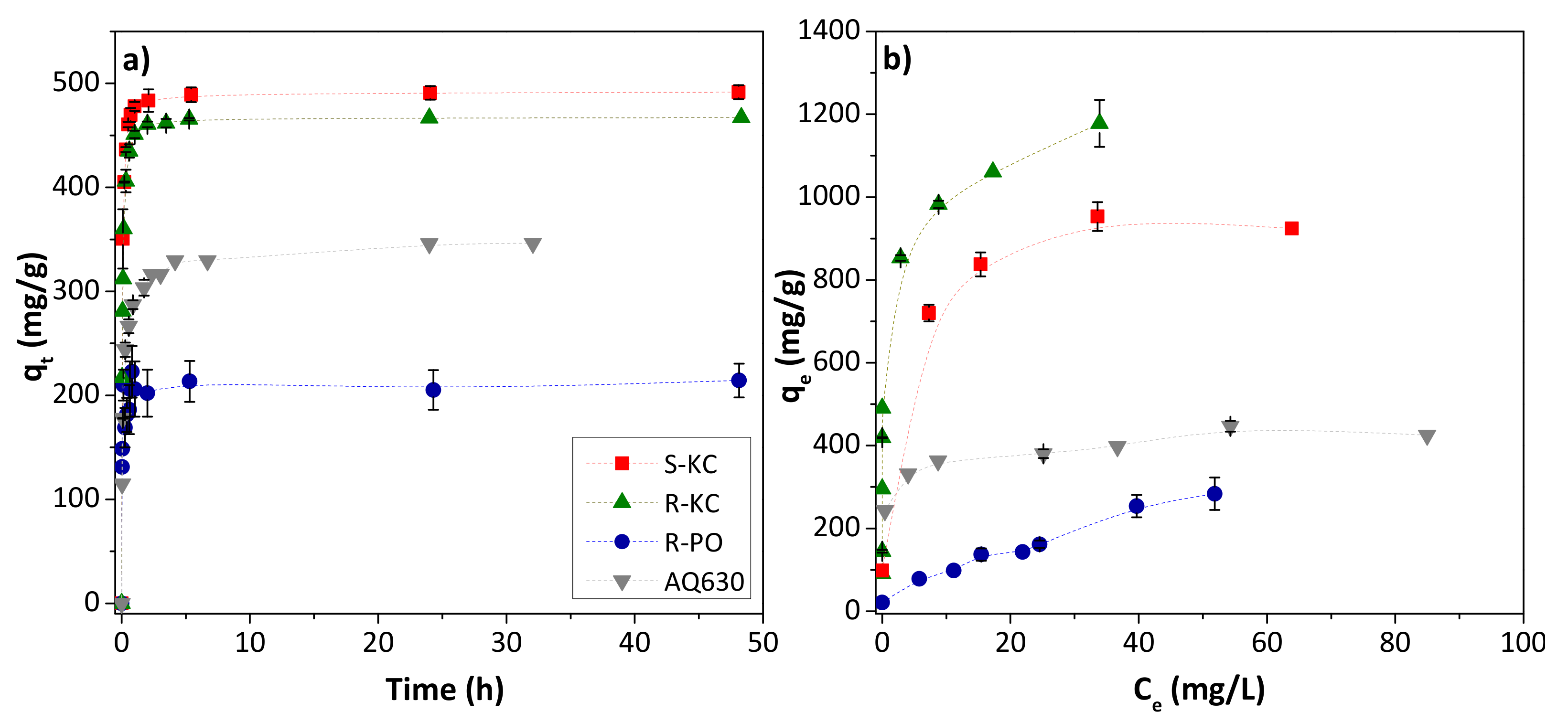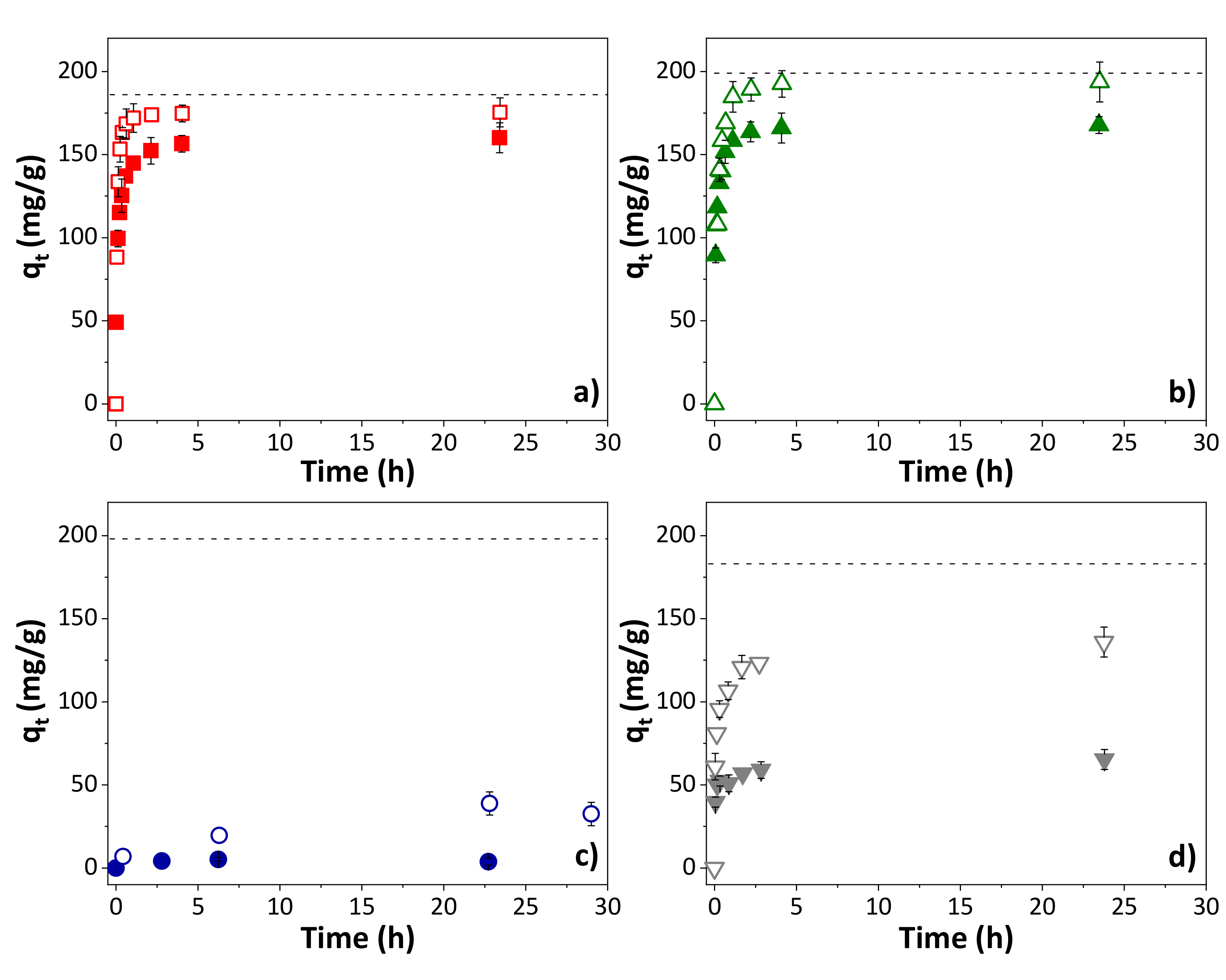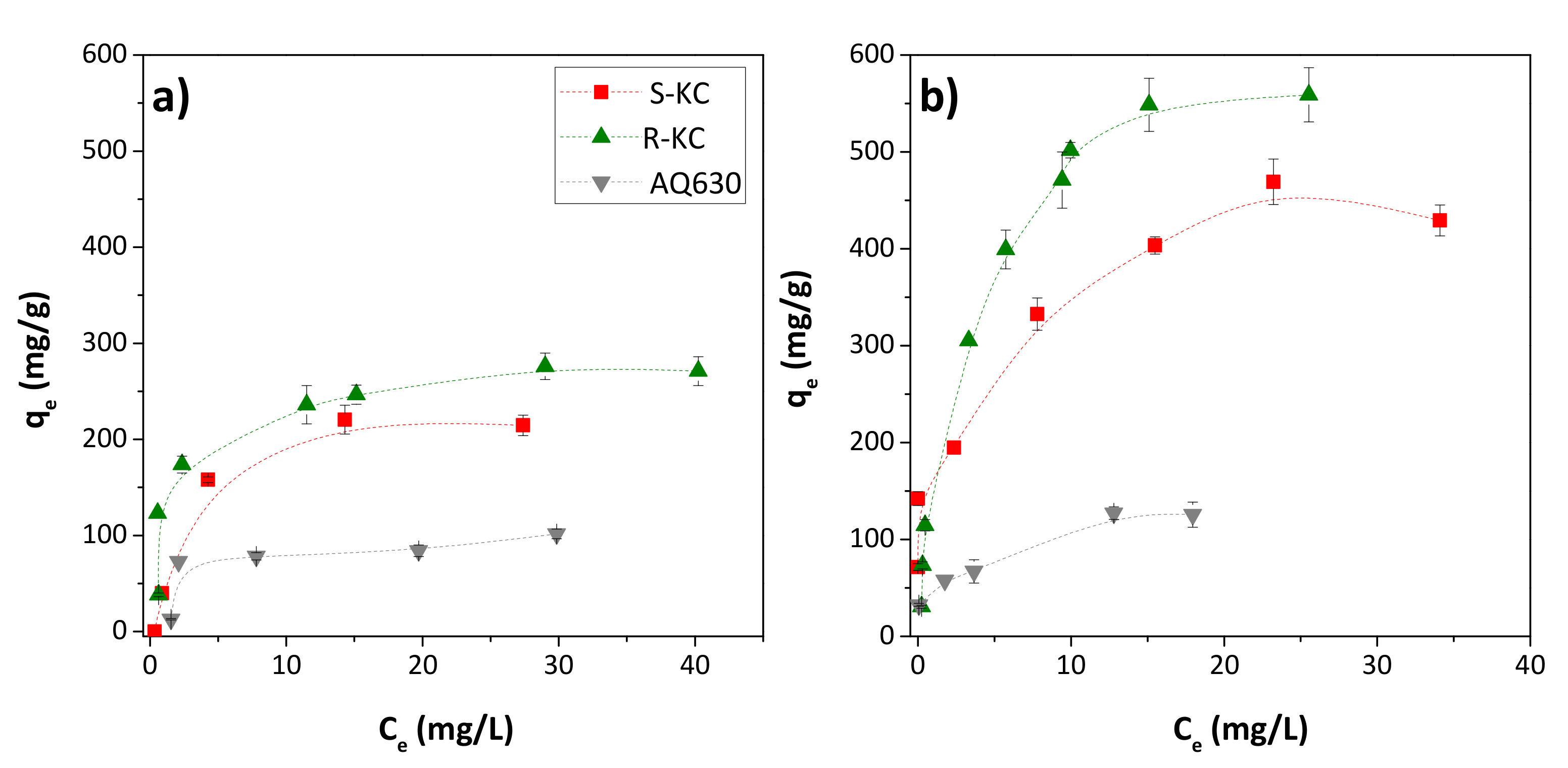Adsorption of Metolachlor and Its Transformation Products, ESA and OXA, on Activated Carbons
Abstract
:1. Introduction
2. Materials and Methods
2.1. Materials
2.2. Physico-Chemical Characterization
2.3. Adsorption Experiments
2.4. Isotherms and Kinetics Models
3. Results
3.1. Characterization of Precursors and Activated Carbons
3.1.1. Composition of the Lignocellulosic Precursors
3.1.2. Physico-Chemical Characterization of Activated Carbons
3.2. Adsorption
3.2.1. Metolachlor Adsorption
3.2.2. Transformation Products ESA and OXA Adsorption
4. Conclusions
Supplementary Materials
Author Contributions
Funding
Conflicts of Interest
References
- Steele, G.V.; Johnson, H.M.; Sandstrom, M.W.; Capel, P.D.; Barbash, J.E. Occurrence and fate of pesticides in four contrasting agricultural settings in the United States. J. Environ. Qual. 2008, 37, 1116–1132. [Google Scholar] [CrossRef] [PubMed] [Green Version]
- Silva-Madera, R.J.; Salazar-Flores, J.; Peregrina-Lucano, A.A.; Mendoza-Michel, J.; Ceja-Gálvez, H.R.; Rojas-Bravo, D.; Reyna-Villela, M.Z.; Torres-Sánchez, E.D. Pesticide contamination in drinking and surface water in the Cienega, Jalisco, México. Water Air Soil Pollut. 2021, 232, 43. [Google Scholar] [CrossRef]
- Tisseau, M.A.; Fauchon, N.; Cavard, J.; Vandevelde, T. Pesticide contamination of water resources: A case study—The rives in the Paris region. Water Sci. Technol. 1996, 34, 147–152. [Google Scholar] [CrossRef]
- Sidoli, P.; Devau, P.; Angulo Jaramillo, R.; Baran, N. Reactivity of vadose-zone solids to S-metolachlor and its two main metabolites: Case of a glaciofluvial aquifer. Environ. Sci. Pollut. Res. 2020, 27, 22865–22877. [Google Scholar] [CrossRef] [PubMed]
- Nazir, M.S.; Tahir, Z.; Hassan, S.U.; Ali, Z.; Akhtar, M.N.; Azam, K.; Abdulah, M.A. Remediation of pesticide in water. In Sustainable Agriculture Reviews 47 Pesticide Occcurrence, Analysis and Remediation; Inamuddin, Ahamed, M.I., Lichtfouse, E., Eds.; Springer: Cham, Switzerland, 2021; Volume 47, pp. 271–308. [Google Scholar]
- Varjani, S.; Kumar, G.; Rene, E.R. Developments in biochar application for pesticide remediation: Current knowledge and future research directions. J. Environ. Manag. 2019, 232, 505–513. [Google Scholar] [CrossRef]
- Rodrigo, M.A.; Oturan, N.; Oturan, M.A. Electrochemically assisted remediation of pesticides in soils and water: A review. Chem. Rev. 2014, 114, 8720–8745. [Google Scholar] [CrossRef]
- Gusain, R.; Gupta, K.; Joshi, P.; Khatri, O.P. Adsorptive removal and photocatalytic degradation of organic pollutants using metal oxides and their composites: A comprehensive review. Adv. Colloid Interface Sci. 2019, 272, 102009. [Google Scholar] [CrossRef] [PubMed]
- Lopez, B.; Ollivier, P.; Togola, A.; Baran, N.; Ghestem, J.-P. Screening of French groundwater for regulated and emerging contaminants. Sci. Total Environ. 2015, 518–519, 562–573. [Google Scholar] [CrossRef]
- Loos, R.; Locoro, G.; Comero, S.; Contini, S.; Schwesig, D.; Werres, F.; Balsaa, P.; Gans, O.; Weiss, S.; Blaha, L.; et al. Pan-European survey on the occurrence of selected polar organic persistent pollutants in ground water. Water Res. 2010, 44, 4115–4126. [Google Scholar] [CrossRef] [PubMed]
- Amalric, L.; Baran, N.; Coureau, C.; Maingot, L.; Buron, F.; Routier, S. Analytical developments for 47 pesticides: First identification of neutral chloroacetanilide derivatives in French groundwater. Int. J. Environ. Anal. Chem. 2013, 93, 1660–1675. [Google Scholar] [CrossRef]
- Baran, N.; Gourcy, L. Sorption and mineralization of S-metolachlor and its ionic metabolites in soils and vadose zone solids: Consequences on groundwater quality in an alluvial aquifer (Ain Plain, France). J. Contam. Hydrol. 2013, 154, 20–28. [Google Scholar] [CrossRef]
- Hladik, M.L.; Bouwer, E.J.; Roberts, A.L. Neutral chloroacetamide herbicide degradates and related compounds in Midwestern united states drinking water sources. Sci. Total Environ. 2008, 390, 155–165. [Google Scholar] [CrossRef]
- Zimmerman, L.R. Analysis and detection of the herbicides dimethenamid and flufenacet and their sulfonic and oxanilic acid degradates in natural water. J. Agric. Food Chem. 2002, 50, 1045–1052. [Google Scholar] [CrossRef] [PubMed]
- Farlin, J.; Gallé, T.; Bayerle, M.; Pittois, D.; Köppchen, S.; Krause, M.; Hofmann, D. Breakthrough dynamics of s-metolachlor metabolites in drinking water wells: Transport pathways and time to trend reversal. J. Contam. Hydrol. 2018, 213, 62–72. [Google Scholar] [CrossRef]
- European Commission (EC). Council Directive 98/83/EC of 3 November 1998 on the quality of water intended for human consumption. Off. J. Eur. Comm. 1998, 330, 32–54. [Google Scholar]
- Otero, R.; Esquivel, D.; Ulibarri, M.A.; Romero Salguero, F.J.; Van Der Voort, P.; Fernández, J.M. Mesoporous phenolic resin and mesoporous carbon for the removal of S-metolachlor and bentazon herbicides. Chem. Eng. J. 2014, 251, 92–101. [Google Scholar] [CrossRef]
- Etcheverry, M.; Cappa, V.; Trelles, J.; Zanini, G. Montmorillonite-alginate beds: Natural mineral and biopolymers based sorbent of paraquat herbicides. J. Environ. Chem. Eng. 2017, 5, 5868–5875. [Google Scholar] [CrossRef]
- Gomis-Berenguer, A.; Laidin, I.; Renoncial, S.; Cagnon, B. Study of enantioselective metolachlor adsorption by activated carbons. RSC Adv. 2020, 10, 40321–40328. [Google Scholar] [CrossRef]
- Liu, L.; Dai, Y. Strong adsorption of metolachlor by biochar prepared from walnut shells in water. Environ. Sci. Pollut. Res. 2021. [Google Scholar] [CrossRef]
- Carrier, M.; Loppinet-Serani, A.; Denux, D.; Lasnier, J.-M.; Ham-Pichavant, F.; Cansell, F.; Aymonier, C. Thermogravimetric analysis as a new method to determine the lignocellulosic composition of biomass. Biomass Bioenergy 2011, 35, 298–307. [Google Scholar] [CrossRef]
- Bandosz, T.J.; Jagiello, J.; Contescu, C. Characterization of the surfaces of activated carbons in terms of their acidity constant distributions. Carbon 1993, 31, 1193–1202. [Google Scholar] [CrossRef]
- Ho, Y.S.J. Review of second-order models for adsorption systems. J. Hazard. Mater. 2006, 136, 681–689. [Google Scholar] [CrossRef] [Green Version]
- Ho, Y.S.; McKay, G. The kinetics of sorption of divalent metal ions onto sphagnum moss peat. Water Res. 2000, 34, 735–742. [Google Scholar] [CrossRef]
- Langmuir, I. The adsorption of gases on plane surfaces of glass, mica and platinum. J. Am. Chem. Soc. 1918, 40, 1361–1403. [Google Scholar] [CrossRef] [Green Version]
- Freundlich, H.M.F. Over the adsorption in solution. Phys. Chem. 1906, 57, 385–471. [Google Scholar]
- Thommes, M.; Kaneko, K.; Neimark, A.V.; Olivier, J.P.; Rodriguez-Reinoso, F.; Rouquerol, J.; Sing, K.S.W. Physisorption of gases, with special reference to the evaluation of surface area and pore size distribution (IUPAC technical report). Pure Appl. Chem. 2015, 87, 1051–1069. [Google Scholar] [CrossRef] [Green Version]
- Puziy, A.M.; Poddubnaya, O.I.; Sevastyanova, O. Carbon materials from technical lignins: Recent advances. Top. Curr. Chem. 2018, 376, 33. [Google Scholar] [CrossRef] [PubMed]
- Font, R.; Marcilla, A.; Verdu, E.; Devesa, J. Thermogravimetric kinetic study of the pyrolysis of almond shells and almond shells impregnated with CoCl2. J. Anal. Appl. Pyrolysis 1991, 21, 249–264. [Google Scholar] [CrossRef]
- Orfao, J.J.M.; Antunes, F.J.A.; Figueiredo, J.L. Pyrolysis kinetics of lignocellulosics materials-three independent reactions model. Fuel 1999, 78, 349–358. [Google Scholar] [CrossRef]
- Cagnon, B.; Py, X.; Guillot, A.; Stoeckli, F.; Chambat, G. Contributions of hemicellulose, cellulose and lignin to the mass and the porous properties of chars and steam activated carbons from various lignocellulosic precursors. Bioresour. Technol. 2009, 100, 292–298. [Google Scholar] [CrossRef] [PubMed] [Green Version]
- Boundzanga, H.M.; Cagnon, B.; Roulet, M.; De Persis, S.; Vautin-Ul, C.; Bonnamy, S. Contributions of hemicellulose, cellulose, and lignin to the mass and porous characteristics of activated carbons produced from biomass residues by phosphoric acid activation. Biomass Convers. Biorefin. 2020. [Google Scholar] [CrossRef]
- Hayashi, J.; Kazehaya, A.; Muroyama, K.; Watkinson, A.P. Preparation of activated carbon from lignin by chemical activation. Carbon 2000, 38, 1873–1878. [Google Scholar] [CrossRef]
- Zhang, S.; Tao, L.; Zhang, Y.; Wang, Z.; Gou, G.; Jiang, M.; Huang, C.; Zhou, Z. The role and mechanism of K2CO3 and Fe3O4 in the preparation of mangnetic peanut shell based activated carbon. Powder Technol. 2016, 295, 152–160. [Google Scholar] [CrossRef]
- Marsh, H.; Rodríguez-Reinoso, F. Activated Carbon; Elsevier: Amsterdam, The Netherlands, 2006. [Google Scholar]
- Molina-Sabio, M.; Rodríguez-Reinoso, F.; Caturla, F.; Sellés, M.J. Porosity in granular carbons activated with phosphoric acid. Carbon 1995, 33, 1105–1113. [Google Scholar] [CrossRef]
- Moreno-Castilla, C. Adsorption of organic molecules from aqueous solutions on carbon materials. Carbon 2004, 42, 83–94. [Google Scholar] [CrossRef] [Green Version]
- Ania, C.O.; Béguin, F. Mechanism of adsorption and electrosorption of bentazone on activated carbon cloth in aqueous solution. Water Res. 2007, 41, 3372–3380. [Google Scholar] [CrossRef] [PubMed] [Green Version]
- Lupul, I.; Yperman, J.; Carleer, R.; Gryglewicz, G. Adsorption of antrazine on hemp stem-based activated carbons with different surface chemistry. Adsorption 2015, 21, 489–498. [Google Scholar] [CrossRef] [Green Version]
- Kusmierek, K.; Bialek, A.; Swiatkowski, A. Effect of activated carbon surface chemistry on adsorption of phenoxy carboxylic acid herbicides from aqueous solutions. Desalin. Water Treat. 2020, 186, 450–459. [Google Scholar] [CrossRef]





| Rape Straw | Sunflower Seed Shell | |
|---|---|---|
| Ashes (%) | 8.2 ± 0.1 | 2.9 ± 0.3 |
| Cellulose (%) | 52.1 ± 0.4 | 43.0 ± 3 |
| Hemicellulose (%) | 15.2 ± 1.1 | 29.2 ± 3.8 |
| Lignin (%) | 4.6 ± 0.6 | 20.1 ± 0.8 |
| Total C (%) | 45.2 | 50.2 |
| P (ppm) | 2366.0 | 236.9 |
| K (ppm) | 15,370.0 | 7110.0 |
| S (ppm) | 5813.0 | 1008.0 |
| Ca (ppm) | 22,690.0 | 3312.0 |
| Sample | SBET (m2/g) | Vtotal (cm3/g) a | W0 (cm3/g) b | Vmeso (cm3/g) c | L (nm) d | Yield * (%) | Elemental analysis (wt. %) | Superficial pH | Acidity (mmol H+/g) | |||
|---|---|---|---|---|---|---|---|---|---|---|---|---|
| C | N | S | O | |||||||||
| S-KC | 2024 | 0.86 | 0.76 | 0.04 | 1.0 | 22 | 88.3 | <0.02 | <0.1 | 5.6 | 6.0 | 1.07 |
| R-KC | 2220 | 1.05 | 0.83 | 0.13 | 1.2 | 15 | 86.4 | <0.02 | 0.5 | 6.6 | 6.6 | 1.85 |
| R-PO | 1466 | 0.72 | 0.49 | 0.14 | 1.4 | 41 | 67.6 | 0.8 | <0.1 | 24.4 | 3.5 | 2.19 |
| AQ630 | 1016 | 0.60 | 0.38 | 0.20 | 1.2 | -- | 84.7 | 0.1 | n.a | 2.3 | 7.4 | 0.94 |
| Adsorbent | Kinetics | Isotherms | |||||||||
|---|---|---|---|---|---|---|---|---|---|---|---|
| qe, exp (mg/g) | qe, exp (removal %) | qe (mg/g) | k2 (g/mg h) | R2 | Langmuir | Freundlich | |||||
| qmax (mg/g) | b (L/mg) | R2 | kf (mg/g)(L/mg)1/nf | nf | R2 | ||||||
| S-KC | 486 ± 3 | 98 ± 2 | 493 | 0.051 | 0.999 | 991 | 0.40 | 0.969 | 599 | 8.7 | 0.958 |
| R-KC | 465 ± 2 | 99 ± 1 | 467 | 0.047 | 0.995 | 1023 | 40.40 | 0.710 | 760 | 8.3 | 0.983 |
| R-PO | 208 ± 6 | 40 ± 2 | 204 | 0.240 | 0.970 | 580 | 0.02 | 0.901 | 19 | 1.4 | 0.940 |
| AQ630 | 340 ± 5 | 77 ± 2 | 330 | 0.034 | 0.983 | 390 | 3.50 | 0.824 | 281 | 10.3 | 0.961 |
| Adsorbent | ESA | OXA | ||
|---|---|---|---|---|
| qe, exp (mg/g) | qe, exp (Removal %) | qe, exp (mg/g) | qe, exp (Removal %) | |
| S-KC | 120 ± 6 | 57 ± 3 | 160 ± 10 | 82 ± 5 |
| R-KC | 137 ± 1 | 68 ± 4 | 166 ± 6 | 82 ± 2 |
| R-PO | 10 ± 7 | 4 ± 2 | 10 ± 6 | 5 ± 2 |
| AQ630 | 76 ± 3 | 38 ± 2 | 60 ± 8 | 32 ± 3 |
| Adsorbent | Metabolite | qmax, exp (mg/g) | Langmuir | Freundlich | ||||
|---|---|---|---|---|---|---|---|---|
| qmax (mg/g) | b (L/mg) | R2 | kf (mg/g)(L/mg)1/nf | nf | R2 | |||
| S-KC | ESA | 218 | 258 | 0.291 | 0.957 | 65 | 2.5 | 0.807 |
| R-KC | 273 | 278 | 0.668 | 0.888 | 118 | 4.0 | 0.824 | |
| AQ630 | 93 | 104 | 0.383 | 0.571 | 38 | 3.4 | 0.502 | |
| S-KC | OXA | 434 | 479 | 0.297 | 0.993 | 182 | 3.9 | 0.851 |
| R-KC | 554 | 644 | 0.311 | 0.989 | 182 | 2.6 | 0.931 | |
| AQ630 | 126 | 380 | 0.280 | 0.789 | 52 | 3.2 | 0.922 | |
| Adsorbent | Initial Conditions | qe (%) | ||
|---|---|---|---|---|
| Cinitial (mg/L) | mg Metabolite/mg Adsorbent | ESA | OXA | |
| R-KC | 8 | 0.2 | 68 ± 4 | 82 ± 2 |
| 0.01 | 0.005 | 48 ± 15 | 48 ± 7 | |
| 0.001 | 0.0005 | 48 ± 11 | 47 ± 6 | |
| AQ630 | 8 | 0.2 | 38 ± 2 | 32 ± 3 |
| 0.01 | 0.005 | 32 ± 5 | 43 ± 4 | |
| 0.001 | 0.0005 | 35 ± 2 | 41 ± 5 | |
Publisher’s Note: MDPI stays neutral with regard to jurisdictional claims in published maps and institutional affiliations. |
© 2021 by the authors. Licensee MDPI, Basel, Switzerland. This article is an open access article distributed under the terms and conditions of the Creative Commons Attribution (CC BY) license (https://creativecommons.org/licenses/by/4.0/).
Share and Cite
Gomis-Berenguer, A.; Sidoli, P.; Cagnon, B. Adsorption of Metolachlor and Its Transformation Products, ESA and OXA, on Activated Carbons. Appl. Sci. 2021, 11, 7342. https://doi.org/10.3390/app11167342
Gomis-Berenguer A, Sidoli P, Cagnon B. Adsorption of Metolachlor and Its Transformation Products, ESA and OXA, on Activated Carbons. Applied Sciences. 2021; 11(16):7342. https://doi.org/10.3390/app11167342
Chicago/Turabian StyleGomis-Berenguer, Alicia, Pauline Sidoli, and Benoît Cagnon. 2021. "Adsorption of Metolachlor and Its Transformation Products, ESA and OXA, on Activated Carbons" Applied Sciences 11, no. 16: 7342. https://doi.org/10.3390/app11167342
APA StyleGomis-Berenguer, A., Sidoli, P., & Cagnon, B. (2021). Adsorption of Metolachlor and Its Transformation Products, ESA and OXA, on Activated Carbons. Applied Sciences, 11(16), 7342. https://doi.org/10.3390/app11167342








